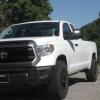From the iH8mud forum:
https://forum.ih8mud...booster.503895/
Detailed post cut and pasted from there below. IF you do this, make sure you know the consequences. This will change how your alternator works. I still think the C-Tek D250S is the better solution, as it only affects the voltage going to the camper batteries, not to the whole truck.
"The generally accepted range of volts out of an alternator for charging is between 13.8 volts to 14.6 volts. On some newer vehicles, (2009 onwards) the manufacturers are electing to us ECU controlled alternators to aid fuel economy and emission figures. Once the starting battery/s reach sufficient charge to start the vehicle (usually around 80%) the alternator drops to a supply voltage of around 13.2 volts.
The minimum voltage to charge a wet cell lead acid battery effectively for optimum performance is 13.8, calcium/calcium sealed maintenance free lead acid is around 14.2 and for flat plate fully sealed agm, gel or spiral wound agm the voltage needs to be 14.4.
So far, the vehicles that I know for certain with these alternators are Toyota LC200, all 70 series and prado 150 series. Toyota started using these alternators around 2009/2010.
So using these diode's to trick the alternator is only needed if you are wanting to use one of the newer technology batteries that require 14.2 or 14.4 and your alternator is only putting out 13.8 or less. If you are achieving voltages of 14.6, count yourself lucky to have a perfect charge voltage. Over 14.6, you will cook your batteries.
My only concern with these Alternator Voltage Booster diodes is that some of them require you to replace the 7.5 amp fuse with the diode and the one I tried about 12 months ago did not blow even at 20amps.
Instead I elect to find the wire that runs between the fuse and the alternator and cut and solder a quick connector in. This allows the ability to replace the diode(built into the quick connector) with a simple jumper wire, returning the vehicle to standard but most importantly retaining the factory 7.5amp fuse."

















